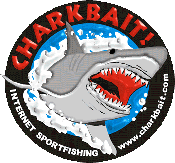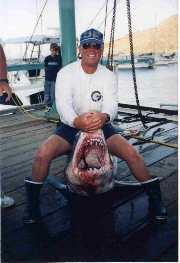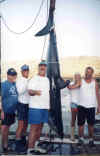|
|
Fishermen's Journal |
Sharkingby Capt. Jerry Barber
Shark fishing is inherently dangerous and particular care must be taken when this type of fishing is undertaken. It gets really dicey when even a moderate sized mako is landed and winds up inside your boat, either accidentally or on purpose (more on that later). There could be a real question as to who is having who for dinner. Several anglers have lost their lives to makos and fishing for them should not be taken lightly. Methods vary in fishing for sharks, or for any other fish for that matter. Everyone has his or her favorite way of angling, baiting, playing and landing the fish. Some people are very set in their ways and insist that their way is the only way. I believe you can learn something from everyone. I have devised my personal way of fishing for sharks by picking and choosing from many sources and lots of trial and error. I offer it for you to pick and choose for yourself, taking and using what works for you and discarding the rest. Fishing is an individual thing. Use what works for you. Sharks are slow growing and do not produce many pups at any one time. It is for this reason that I stress conservation when fishing for them. I have seen anglers come in with 30, 40 and 50 pound makos strapped to their swimstep, proud as can be that they conquered a vicious denizen of the deep. That size fish isn't even out of diapers and should have been released. Don't get me wrong. I am not a tree-hugger, but I am for rational conservation. It is for this reason I further suggest releasing all females and taking only the males unless extraordinary circumstances dictate otherwise. As anglers, it's for our own good and, to me, makes good sense. Makos are normally 23 to 27 inches long at birth and a female generally has four to eight pups to a litter. Males mature at around six feet and four years of age. Females mature at around nine feet and eight years of age. Makos are the fastest of all sharks and should be considered EXTREMELY dangerous. Makos will jump and some have landed inside boats, sometimes with disastrous results. Threshers are normally 27 to 41 inches long at birth and the females normally produce from two to six pups in a litter. The males generally mature at around six feet long (fork length) or eleven feet total length and the females at seven feet (fork length) or twelve feet total length. Males are readily distinguished from the females by the anal fins adjacent to the vent. Both males and females have small fins on each side of the vent, but males have additional appendages, known as claspers, on the inside of each fin. These claspers are round and somewhat pointed and extend behind the anal fins. Heavy equipment is a must for shark fishing. You never know when that monster is going to hit. Heavy trolling rods, preferably all roller, with large two-speed reels loaded with good quality 60 to 80 pound line is the tackle of choice by most shark fishermen. I do have a lighter rod handy for those smaller sharks that wander by to sniff the chum bucket without picking up a bait. Now, right off the bat, we have a choice to make. Several anglers I know prefer not to put out any baits until they actually see the fish. They have several different outfits handy so they can then match the rod to the size of the fish. I prefer to use smaller hooks than most others. My hooks are generally Mustad 7691's in an 8/0 size. I know a lot of people use 12/0's, 14/0's and even larger, but I feel I get better penetration, especially into the jawbone, with a smaller hook. Use whatever hook you like, but I have found that a good quality, forged, welded eye hook is the one to use. Be sure to set the hook several times...HARD! A shark has a tough jaw. Shark fishing necessitates the use of wire leaders. Barry Andersen, an excellent tournament shark fisherman, uses 30 foot long, six hundred pound test stainless steel cable. This obviously calls for a leader man, as you couldn't get a shark close enough to gaff with a 30' leader. Barry has a 42' sportfisher Huh-Dad II and generally fishes with a crew of five. He has the equipment and the manpower to use long leaders and to handle large sharks. For the small boat enthusiast, a 30' leader is not practical. I use six foot leaders made of 400# uncoated Sevenstrand wire, double crimped and protected with springs or thimbles. When using shorter leaders, you might take a look at a wind-on leader as described in Fred Archer's book. Basically, you use hollow core dacron line and insert a 400# test length of mono inside the dacron. When pulled tight, the dacron line shrinks like a Chinese finger torture and holds the mono securely. The harder you pull, the tighter the hold. Once tightened, Super Glue holds the dacron in place and keeps it from loosening. The 400# leader gives the extra protection needed if a shark rolls on you but can still be wound close enough for a gaff shot without using a leader man. There are two standard methods of fishing for sharks, chumming and trolling. Each method has its proponents and opponents. Let's talk about chumming first. It's fairly simple to do and it produces results. There are several types of chum available. There is the standard frozen ground up fish chum, blocks of frozen ground up mackerel and freeze-dried chum. My personal favorite is the ground mackerel. Mackerel is a very oily fish and I just like the slick it provides. The other frozen chum (Mr. Chum or Bongo's) works very well too. I have never liked the freeze-dried chum which relies on a can of cat food to produce a smell and have never had good results with it. To start a chum slick, cut five triangular holes in a large five gallon plastic chum bucket, about an inch to an inch and one-half on a side, one on each side of the bucket and one on the top. Suspend the bucket so it is just below sea level rather than let it float out from the boat. That way, the rocking of the boat jerks the bucket and produces a good steady stream of chum. You also might consider priming the area by using a small bucket of thawed chum which, when hung over the side, dissipates rapidly and creates a solid starting point. You also might have a bait catching rig handy because chum buckets also attract schools of mackerel which you can use to supplement the frozen chum. Cut the mackerel into chunks or grind them with a commercial duty hand powered meat grinder mounted on the rail. Now...the chum slick is working and everything looks good. If the drift is too fast, deploy a sea anchor to slow you down. I set out four poles, two high and two low. The high baits, or floaters are suspended by either balloons or small pieces of styrofoam and the low baits are unweighted and float at their natural depth, depending on the amount of line out and the rate of drift. Vary the distance from the boat as well so all four baits are at different depths and distances. The actual bait on the hook can be just about anything. Preferred baits include whole and fileted mackerel, squid, barracuda filets and squid and mackerel sandwiches. Now get the rest of the equipment ready to go...before you need it. Set up the flying gaff and have it ready to go. A standard gaff also needs to be handy. Other necessary items include a pair of gloves, tailing rope or cable, a LARGE knife, wire cutters and a release device. I recommend the commercially made release device, such as the Accurate Predator Release Stick, which can remove most hooks and lures from a shark=s mouth without danger to you. I recommend them. My tailing rope is a combination device that can be used two ways. I have a 10' length of 1/2" nylon line with a large eye spliced in one end and a large strong bronze snap spliced into the other end. With a moderate sized shark, the tail can be held by hand or gaff and the line quickly placed around the tail and snapped back into itself to form a lasso around the tail. The eye secures the tailing rope to a cleat. With a large shark, a second piece of the device is put into play. I have an eight foot piece of 1/4" plastic coated cable made up with crimped eyes in each end. When the shark is at the boat, the cable is placed around the wire leader and one eye is fed through the other, forming a loop. The snap from the tailing rope is then snapped into the free eye. The stiff cable loop is then worked down over the shark and onto the base of the tail where it is then snugged up. Slack off on the reel's drag, put the boat in gear and you are now dragging the shark backwards to drown it (or at least calm it down). When the shark is subdued, it's time to actually land it. If your boat has a swimstep, that's the place for it. If not, you either drag it alongside or bring it into the boat. I have one rule that I NEVER break. Rule #1 states, No shark comes into my boat with it's head on...period! When I first started sharking, I once brought a seven foot mako into my boat that had been shot three times with a .357 magnum. That shark was DEAD...or so I thought. We had finished the obligatory high fives and taken more than a few pictures when the dead shark came back to life. Picture a seven foot, totally pissed off mako in an 18' center console and you get the picture. One of my crew ran to the back of the boat and was sitting on the outboard, screaming at the top of his lungs to shoot the S.O.B. All I could do was to jump on it's back and hold it's head using the eye sockets. The other crew member grabbed the large knife and handed it to me. I promptly severed it's spine and the fight was over. The boat was a mess, I was totally covered with blood but, luckily, no major damage was done. Rule #1 was immediately put into effect! The second general method of shark fishing is trolling for them. Most experts agree that a downrigger is an almost absolute necessity, especially when targeting threshers. Watch your meter and find out where the bait is. A good rule of thumb is that if you aren't finding bait, you wont find sharks. When you do find the bait, set your downrigger at the depth of the bait and work it thoroughly. If you have to buy a rigger, I strongly suggest a Z-Wing over a weighted ball, even a streamlined weight. The Z-Wing and the streamlined weight keep the same approximate cable angle, no matter what the ads say. Both are far better than a round ball. The advantage comes in its lighter weight (doesn't chip the fiberglass) and space-age material construction (doesn't rust). Be sure to set the lure about 100 feet behind the weight. Makos have a way of charging a bait and eating the balls. Along this same line, NEVER set the brake on the rigger tight. Tighten it just enough to hold the cable from paying out. That way, if a shark does eat the ball, all you will lose is the weight and cable. It won't rip the whole downrigger off your boat, base and all...and probably with a good chunk of boat as well. When trolling, I generally drag three lines, a downrigger on one side with a surface lure on the same side and a diving lure on the opposite side. That way, the three lures are all at different depths.
Because I am almost always tagging when I am shark fishing, my primary interest is to
get a tag into the shark and get it released as soon as possible, using the Predator
A very good example of the power of a large shark happened recently when a fisherman in a 25 foot boat (a Skipjack) hooked up to a thirteen foot mako. After almost eight hours, the fish was brought to gaff. The fish was stuck with two heavy flying gaffs and a tailing rope was secured through a hawsepipe to a cleat. The shark broke free, straightened both flying gaffs and, when it reached the end of the tailing rope, ripped the cleat right off the gunnel. When the cleat tried to go through the hawsepipe, it jammed and ripped the hawsepipe and a 12" section of the hull completely off the boat. Sharking is great sport but, again, inherently dangerous and
great care should be exercised when fishing for them. Novices should go out with a veteran
for a few trips before venturing out on their own. If you really get into it, consider
tagging sharks for research. Its fun and very rewarding. For tagging information and
applications, contact John Ugoretz, Pelagic Shark Tagging Coordinator, California
Department of Fish and Game, 330 Golden Shore, Suite 50, Long Beach, CA 90802. John is
leaving the shark tagging coordinator position in a few months and will be sorely missed.
The new coordinator has some big shoes (sea boots?) to fill. |
| (John has supplied a copy of the application you'll need to fill out so that you can get involved with the California Shark Tagging Program. Please click on the link to the DFG information. DFG SHARK PROGRAM) |
You too can get published right here at CharkBait. Have an idea other boaters or fishermen could use, some experience to share, a great trip to report? Well, get typing, include some pics, and if your article is selected for publication you'll receive a free CharkChirt and the appreciation of other fishermen. |
Thank you for visiting!
If you have any questions please contact me through e-mail.
© CharkBait 1998/9


























































